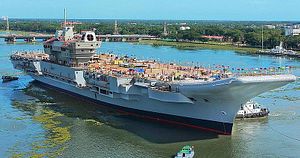India’s first domestically built aircraft carrier, the future INS Vikrant, designated IAC-1, is expected to commence sea trials in 2020, the head of the Indian Navy, Admiral Sunil Lanba, told reporters in New Delhi on December 3rd. The new carrier is reportedly slated for induction into service with Eastern Naval Command in the same year.
Notably, a 2016 assessment published by the Comptroller and Auditor-General (CAG) — the Indian government’s principal oversight body—stated that the carrier would only be ready for induction in 2023. That analysis, however, was rejected by the Indian Navy earlier this year. “That was CAG’s version, as far as Navy is concerned, we are confident,” of meeting the earlier deadline, Commodore J. Chowdhary, the Indian Navy’s principal director of naval design, said in January.
The future INS Vikrant has now entered its final phase of construction at Kochi shipyard as part of the Indian Ministry of Defense’s Maritime Capability Perspective Plan, according to Lanba. Work on the carrier began in 2009. The new carrier, the lead vessel of the Indian Navy’s Vikrant-class, the first carrier class to be designed and built in India under Indigenous Aircraft Carrier (IAC) program, was officially launched in August 2013 and relaunched in June 2015.
The Vikrant was supposed to commence sea trials already in 2017 with a previous commissioning date set for 2018. Originally, the carrier was slated for delivery in 2014 and set to be commissioned in 2016. Yet, the IAC program faced delays for various reasons as I explained previously:
Construction of the carrier was delayed multiple times over the last few years primarily due to hold-ups in procurement including contractual disputes with Russia’s Rosoboronexport over the construction of the carrier’s aviation complex.
The program has also been plagued by cost overruns with the carrier, as of now, costing as much as $4 billion more than originally budgeted. Indian Prime Minister Narendra Modi allocated an extra $3 billion to the IAC program in 2014 to speed up construction of the Vikrant.
The 40,000-ton Vikrant operates a ski-jump assisted Short Take-Off But Arrested Recovery (STOBAR) launch systems for launching aircraft. “[The] STOBAR system imposes limits on the operational range and armament of aircraft operating from the carrier given that ski-jump takeoff and arrested carrier landings necessitate a high thrust-to-weight ratio for successful take-offs and can only be conducted with lightweight aircraft,” I explained elsewhere.
The carrier will be able to accommodate up to 40 aircraft including Russian-made MiG-29K Fulcrum fighter jets the current backbone of Indian naval aviation, Kamov Ka-31, HAL Dhruv, or Westland Sea King helicopters. The carrier’s hangar can accommodate up to 17 aircraft, while the remaining planes can be stored on the flight deck.
































